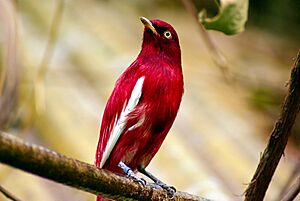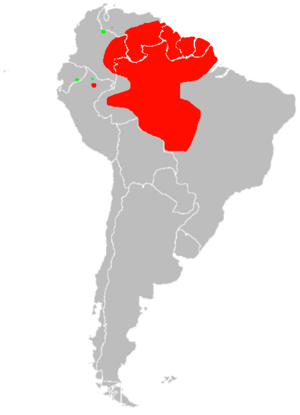Pompadour cotinga facts for kids
Quick facts for kids Pompadour cotinga |
|
|---|---|
 |
|
| Male perched pompadour cotinga | |
| Conservation status | |
| Scientific classification | |
| Genus: |
Xipholena
|
| Species: |
punicea
|
 |
|
| Pompadour cotinga distribution:
Year-round range Vagrant range |
|
| Synonyms | |
|
|
The pompadour cotinga (Xipholena punicea) is a colorful bird that lives in the Amazonian rainforest. You can find these birds across the Amazon Basin. Their home includes countries like Brazil, Peru, Colombia, Venezuela, and the Guianas.
Pompadour cotingas mostly eat fruit. But sometimes, they also snack on insects. These birds are special because the males look very different from the females. Male cotingas have a deep burgundy body, bright white wings, and yellow eyes. Females are a pale grey color.
Males do amazing dances to attract females. After mating, the female raises the young birds all by herself. It's hard to watch these birds in the wild. This is because they live high up in the trees. Even with threats to the Amazon, the pompadour cotinga is not currently in danger.
Contents
Discovering the Pompadour Cotinga
The pompadour cotinga was first written about in 1764. It was in a list of animals for sale. This list was made by a Dutch collector named Adriaan Vroeg. A scientist named Peter Simon Pallas described the bird in Latin. He called it Turdus puniceus.
Birds in the Cotingidae family, like the pompadour cotinga, share some traits. They often have hooked beaks. Males and females look very different. Also, the males usually perform special mating dances.
Scientists have studied these birds' family tree. They found that pompadour cotingas are quieter than many other cotingas. This quiet behavior is shared with their close relatives, the Carpodectes. Both types of birds also have bright white wings. They show off these wings when they fly through the trees.
What Does a Pompadour Cotinga Look Like?
Male and female pompadour cotingas look very different. This is called sexual dimorphism. Males are bright and colorful, while females are more plain.
Male birds have striking yellow eyes. Their wings are bright white with black tips. Their head and body are a shiny, wine-red color. Scientists used to think this color came from a mix of blue and red. But new studies show it comes from special pigments. These pigments are called carotenoids. The pompadour cotinga makes six unique carotenoids. Other birds don't use the same way to make these colors. This makes the pompadour cotinga's colors very special.
Both male and female cotingas have a short beak and a wide mouth. This helps them eat fruit. Not much is known about their eggs. But they are described as bluish-grey with spots. Baby cotingas change color from white to blotchy grey. This might help them hide in their nest.
Where They Live
Pompadour cotingas live in the top layer of rainforests. This layer is called the canopy. They are found in parts of Brazil, Colombia, Venezuela, and the Guianas.
In the northern Amazon in Peru, they live in special white sand forests. They often look for food in groups. They like to forage in Caraipa tereticaulis trees near the Nanay River. These birds usually live where there is thick plant life. The soil there is often white and sandy. It gets dark and acidic from decaying plants.
Sometimes, these birds are seen outside their usual home. There have been rare sightings in Bolivia and eastern Ecuador. These birds are called vagrants.
Behavior
What Pompadour Cotingas Eat
The pompadour cotinga mainly eats fruit. But they will also eat insects if they get the chance. They often look for food in small groups. They make a "PURP!" sound to talk to each other.
Sometimes, captive cotingas have been seen eating bigger prey. One male cotinga was seen catching an anole (a type of lizard). He hit it against a branch before eating it. During breeding season, cotingas might eat more meat. This is because they need more energy to feed their young.
Reproduction and Mating
Scientists haven't seen much of the pompadour cotinga's breeding in the wild. But they know the males have a complex mating dance. The exact breeding season is not known.
Males gather in small groups where a female is building a nest. The males then chase each other in a special way. This might show the female which male is strongest. As each male flies to take another male's spot, they flash their bright white wings. The female watches this display from below. These mating dances are usually quiet. But you can hear a slight sound from their wings moving. A pair forms after mating. But this relationship ends once the female starts nesting.
Raising the Young
Not much is known about how pompadour cotingas care for their young. Females are the main caregivers for the babies. They usually lay only one egg per nest.
An ornithologist named Marcelo Barreiros watched a female cotinga. She was very careful with her single egg. She only left the shallow nest to find food. After the chick hatched, the mother spent most of her time shielding it from the sun. The mother also fed the chick berries. She even ate the chick's waste to keep the nest clean.
Pompadour Cotingas and Humans
The pompadour cotinga is currently listed as a species of least concern. This means they are not in immediate danger. This information comes from a study in August 2018.
However, the destruction of the Amazon rainforest is a problem. It harms the homes of these birds. Scientists think the species could lose about 11-12% of its habitat. This could happen over three generations. The bird population would also decrease. Luckily, there are protected areas for land and water where they live. But the bird itself is not protected by any international laws. There is no plan for how to help them if a disaster happens.
Studying the pompadour cotinga is hard. They live high in the rainforest canopy. They are often hidden from view. Some researchers want to use cranes to reach the canopy. This would help them observe the birds better. Living in the canopy has a benefit. Birds that live high up can leave areas of danger more easily. This helps them survive better than birds that live lower in the forest.


